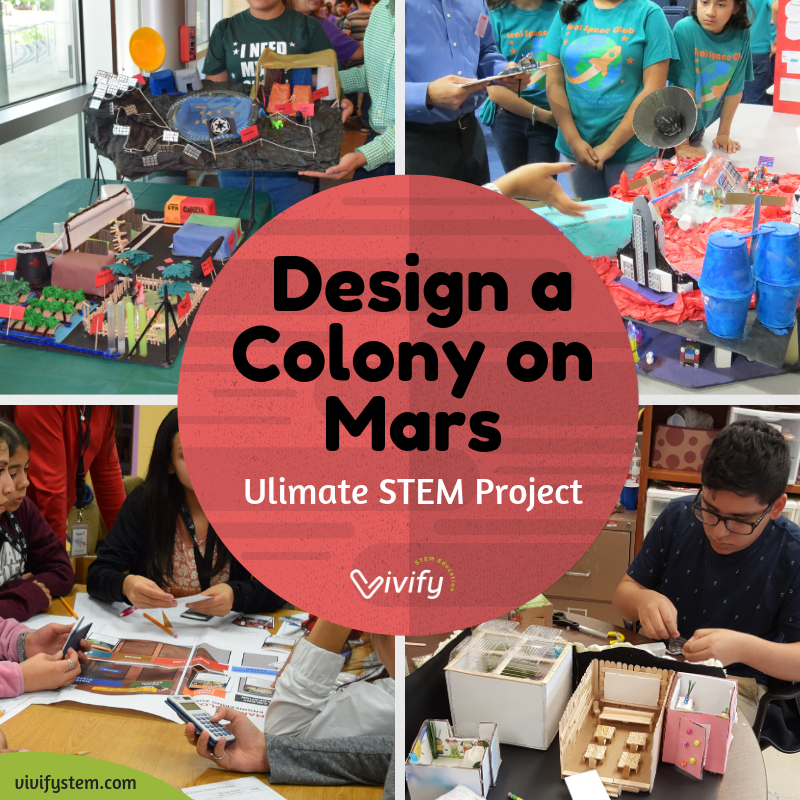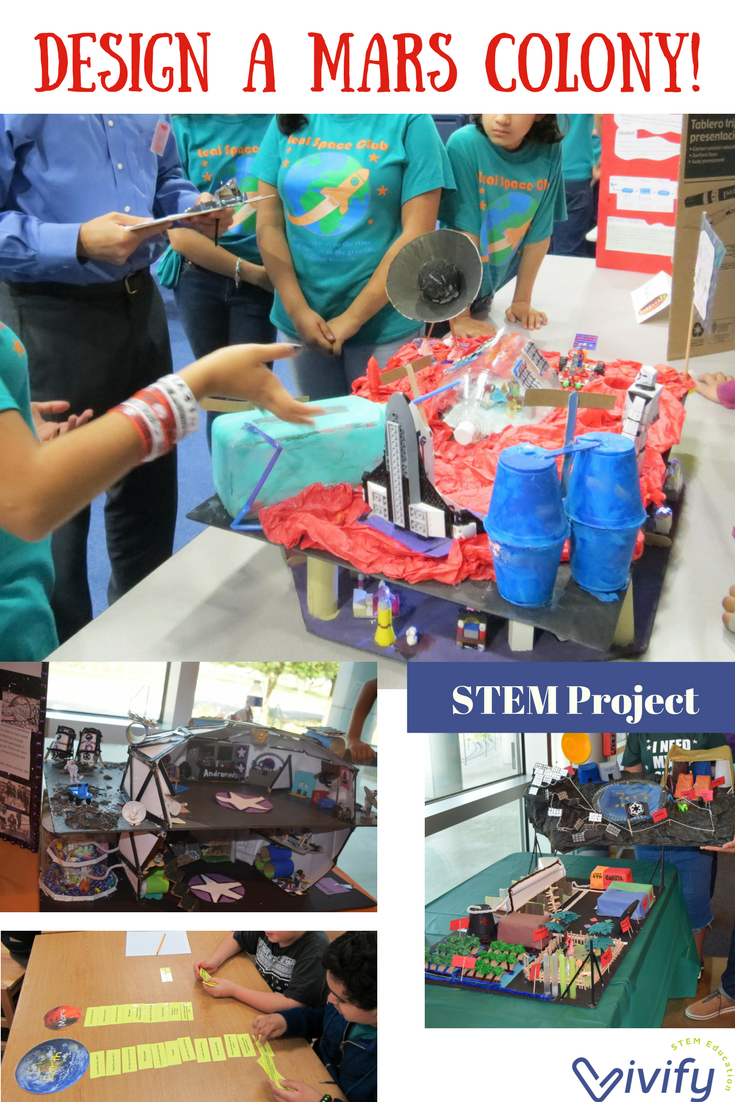Design a Mars Colony: STEM Project
By Dr. Natasha Wilkerson
Originally Posted: May 2, 2019
Updated April 2025
Are you looking for the ultimate project-based STEM challenge? Do you need an engineering or science fair project or summer STEM showcase?
We are excited to share our popular Stage 3 STEM project: designing a colony on Mars! Students learn about Mars, brainstorm and research design solutions for food, water, energy, and other critical systems, and build a colony model from recycled materials. This is the perfect way to take your STEM or STEAM program to the next level with a project-based STEM challenge! Now updated for distance learning!
Designing a Mars Colony is a real multidisciplinary project as students consider both keeping humans alive and happy. How will colonists get food? What is the Martian environment like? What happens during a dust storm? How will colonists stay entertained?
The Mars Colony is the capstone project for my STEM program, and I have been tweaking and improving it over the last five years. Our curriculum is the basis for a city-wide STEM competition in San Antonio, Texas, but you can easily use this guide for your own classroom or program showcase. And Vivify has a big announcement coming soon on a national level space colony competition open to all schools!
“This has been my best purchase this year. We are 8 weeks into the project and my kids (4th and 5th grade gifted) will be finishing their colony models this week. They have been actively engaged in every part. They have by far done some of their best research with this project. Simply amazing!”
Mars Colony STEM Challenge Overview
Bring current events into your classroom with a colony on Mars! SpaceX, NASA, and others are making plans to send humans to Mars, and this project allows students to design their own version of a colony. Keep in mind that you don’t need to be an expert on Mars! Students will take the lead on research, design, and building. We have a project guide, activities, and interactive planning tools that guides teams from brainstorming to building!
The challenge: Design a long-term habitat to keep colonists alive and happy on Mars.
Grade Levels: Adaptable for 4th - 9th grades
Duration: Minimum 10, 1 hour sessions
Project Outline:
Identify the Problem (1 session)
Brainstorm Solutions (2 sessions)
Plan Colony Layout (2 sessions)
Test and Re-Design Layout (1 session)
Build Colony Model (3+ sessions)
Present Design (1 session)
Step 1: Identify the Problem
To understand this challenge, we must first reflect about our lives on Earth. What do we need to survive? What do we need to be productive and happy humans? Students learn that life is more than the basics of food, water, air, and shelter. We need social interaction, community, learning, purpose, and more!
Next, how can we create this life on Mars? Students will need to explore Martian atmosphere, gravity, geography, and resources to determine what is lacking. My students complete an online scavenger hunt, explore the Google Mars map, teach the class their knowledge through a skit or PSA, and play Mars trivia games. All these activities can be found here!
Here are some of my favorite Mars videos to introduce the project:
FREE! Living in Space
Sorting Game
The sorting activity is to jump-start students thinking about a colony on the Moon or Mars that fits within the “Identify the Problem” phase of the project listed here. The goal is to facilitate rich discussions on what students might want in a new human civilization on the Moon or Mars!
Step 2: Brainstorm Solutions
Now that students have a basic understanding of Mars, they need to start planning their colony design to keep humans alive and happy. Research and brainstorming solutions center around two questions:
What current or new technology will keep humans alive on Mars?
How can you prevent mental health problems on Mars?
I asked students to research solutions for the following challenges they will face: Food, Water, Air, Energy, Transportation, Entertainment, Government, and Homesickness.
WARNING: Students don’t know how to research! I know this is shocking to hear. My middle school students' “research” was Google Images or Wikipedia. Students were overwhelmed with the open-ended research phase and missed a lot of cool NASA technologies. I ended up having to heavily guide their efforts to keep solutions based on reality.
Mars Planning Game!
This year, I changed things up. I decided to introduce possible solutions through a game! Through game cards, students are introduced to real NASA technologies such as hydroponics, solar tents, MOXIE oxygen generator, and more. As students read each game card, they debate the pros and cons of real technologies to support their mission to Mars. Teams must also stay within budget and power limits and maintain happiness levels.
And it WORKED! Students loved playing the game, had meaningful debates on each system, and it was the perfect introduction to their colony design. They could visualize all the required systems on two large planning boards, and teams were able to cohesively map out their designs. The game cards gave just enough information to spark interest leading to further research to understand the system.
Step 3: Building Layout
Once solutions are determined for each colony “zone” such as food, water, energy, and communication, teams need to think about the overall design. In the past, I would have teams draw out different designs, but it was difficult to make this a team effort. This year, we used a large poster board as the colony map, and students cut out different colored squares to represent each zone. For example, one square was the sleeping areas, another the power systems like solar panels, and a third area was the bathrooms. Each zone was based on a relative scale to ensure that a toilet wasn’t the size of a cafeteria!
As students laid out the zones, they could determine if multiple levels were needed as well as integrate geography of Mars. Different colors represented various elevations in the colony such as the edge of a crater or inside a lava tube. Our guide in step 2 walks you through this process.
Step 4: Testing
Time to put each colony to the test! Once all systems are planned out, I challenge teams with real-world scenarios to see if their colony can survive. This provides an opportunity for re-design before the building phase. Examples of scenarios:
A massive dust storm has hit your colony, and meteorologists predict it may last for months. The dust storm blocks out most sunlight.
The order in your colony is falling apart. Some colonists are becoming lazy and not working assigned jobs. Others are being wasteful and taking long showers or using electronics excessively.
After eating the same food for months, colonists are getting bored and depressed because of limited food options.
Colonists miss their friends and family back on Earth.
I also ask a local architecture company to come out and provide feedback on colony layouts. This is a great time to add in STEM professionals as mentors for teams!
Step 5: Building Colony Model
Time for the fun part! Students bring in recycled materials, everything from cardboard to cereal boxes, to create a 3D model of their colony. We build on foam boards that are the same size as the poster board used for the 2D layout. This allows students to use the same scale from the layout for building. Here is my process for building with a large team:
Assign each team member a zone such as food, water, sleeping areas. I typically give each student an engineering and mental health zone as the engineering zones take more research.
Each student researches the system with provided websites to learn more on how it works and what it looks like. We used a Google Slide to collect information and photos.
Each student builds a scale model that fits in their assigned zone on the colony board.
Each student glues down model to the colony board.
Each student teaches other team members about their zone.
Step 6: Present Model
Take the project to the next level by submitting to the virtual Space Colony Competition!
The Space Colony Competition is open to any team of up to 6 elementary or middle school students. Learn about the challenges of living in space, research and design a colony, and build a 3D model using recycled materials. Then, upload a video and presentation for a chance to win prizes, get feedback from real STEM professionals, and compete with students around the world! Click here to register!
Ready to implement this in your classroom or program? Check out our full project guide below!







